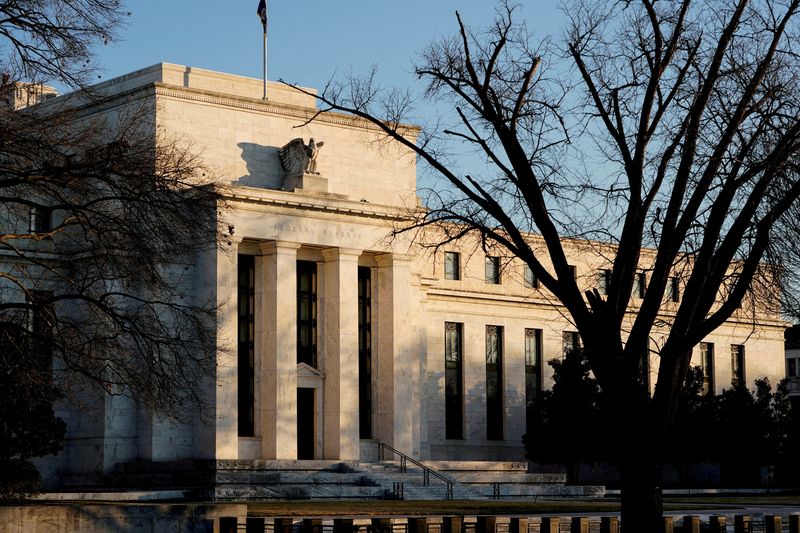By Howard Schneider
WASHINGTON (Reuters) – U.S. Federal Reserve officials appear on track to end the year with interest rate hikes as a thing of the past but with a coming challenge over when and how to signal a turn to rate cuts that investors, politicians and the public may demand before the central bank is ready.
The issue may seem distant. A closely watched gauge of underlying inflation remains at 3.5% year-over-year, significantly above the Fed’s 2% target, policymakers still worry about its resurgence in a low-unemployment economy, and officials’ rhetoric points more to an extended rates plateau or even another hike.
But the hawkish tilt in their words is also a way to keep options open at a time of uncertainty even as the outlook has made Fed officials increasingly confident that the federal funds rate range of 5.25% to 5.5% in place since July is enough to take some steam out of the economy and lower inflation the rest of the way.
Deciding that inflation has fallen enough to start cutting rates may be down to a matter of months, with the complications of presidential election-year politics, itchy financial markets, and hopes to limit any rise in the unemployment rate all coming into play.
The first step toward that debate will occur at the Fed’s final meeting of the year on Dec. 12-13, when in addition to deciding what to do with interest rates now officials must pencil in where they think rates likely are headed next year and beyond.
“They will have a real awkward time in December,” with the projections likely showing interest rate hikes at an end, but Fed officials not wanting that to be construed as a weakening of their commitment to 2% inflation or as a signal that cuts are imminent, said Vincent Reinhart, Dreyfus & Mellon chief economist and a former top Fed monetary policy official.
Since June, the quarterly “dot plot” of policymakers’ projections of the appropriate path of policy has shown rates rising another quarter point this year.
“They’ll have to remove a ‘dot’ without the headline being ‘Fed won’t raise as much’…Anything you say that hints at easing adds to the inherent bias” to cut rates, Reinhart said.
Policymakers next week are expected to hold rates steady for the third meeting in a row and in a new policy statement take stock of data that has largely moved in line with a “soft landing” in which economic activity and job growth slow modestly as inflation steadily declines.
One challenge will be reconciling that assessment with officials’ desire to keep an open option for further rate increases if inflation does not behave as hoped.
Even more telling: As they did in September, the updated projections are likely to show interest rates will be lower by the end of 2024, focusing attention on the fact that the next move more likely than not is a rate reduction, and triggering debate about when that becomes appropriate.
‘GETTING WHAT WE WANTED’
With a presidential election in November, the closer Election Day comes the more tangled in politics a rate cut may appear – particularly if former President Donald Trump, who was angered when the Fed raised rates on his watch, is the Republican nominee as most polls now predict. Investors will be eager for the boost a rate cut would give to markets, and consumers will be relieved by lower mortgage and credit rates.
The December meeting is likely to “give you a dot plot that suggests ‘okay, we’re done hiking…and we’re forecasting cuts,'” said Michael Gapen, U.S. economics chief at Bank of America. “It is tricky to communicate,” since the aim of the cuts won’t be an economic rescue, as rate cuts often are, but an effort to keep pace with falling inflation and steady the “real” cost of borrowing.
Gapen expects the Fed to turn towards a “cautious, gradual easing cycle” once the Personal Consumption Expenditures Price Index, the inflation rate used to determine its 2% target, falls significantly below 3%, with three- or six-month annualized averages at around 2.5% or less.
Indeed, in remarks last week Fed Chair Jerome Powell noted that over the last six months inflation had averaged around 2.5%.
Investors, meanwhile, have become increasingly fixed on March as a starting point for rate cuts.
The mistake of cutting too soon, before inflation is convincingly on its way back to 2%, is one that Powell has explicitly pledged not to make, citing the experience of Fed officials in the 1970s who loosened policy prematurely. That allowed higher inflation to become more embedded, and forced their successors to impose such strict monetary medicine that it pushed the economy into recession.
“We are prepared to tighten policy further if it becomes appropriate to do so,” Powell said Friday in final remarks before the Fed’s traditional blackout period on public policy comments before each Federal Open Market Committee meeting.
Yet the language has begun to shift, with even inflation hawks like Governor Christopher Waller last week outlining why he is confident inflation will continue to decline without further rate increases, and noting that three to six months more progress could be adequate to justify a lower policy rate.
Powell, in an appearance at Spelman College in Atlanta, summed it up.
Between falling inflation and a modest slowdown in growth, Powell said: “We are getting what we wanted to get.”
(Reporting by Howard Schneider; Editing by Andrea Ricci)
